Types of Wire and Cable
There are two basic types of wire: STRANDED and SOLID CORE. Stranded wire is more flexible than solid core wire, and solid core wire is less expensive, carries more current, and handles harsher environments. Wire is available individually, in jacketed bundles, and in shielded jacketed bundles. It is also available in coaxial arrangements where a central wire is surrounded by an insulator and then a conductive foil or braid.
Jacket refers to an insulating cover around a wire or wires, and shield refers to a conductive sheath that surrounds but is insulated from a wire or wires. The purpose of a shield is to act as a Faraday Cage and block electromagnetic interference, to prevent the wire from emitting it, and to block it from reaching the wire.
Fiber-optic cable is another type of cable that conducts light instead of electric signals. It is used for transferring high rates of data as it can transmit very high frequency signals. Fiber-optic cables also provide electrical isolation, which is important for long-distance connections that can have large earth ground voltage differences. And, they do not emit electromagnetic interference nor are they susceptible to it.
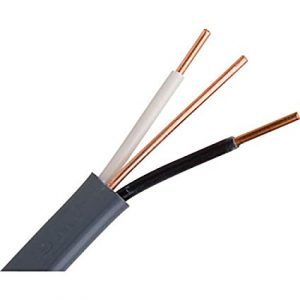
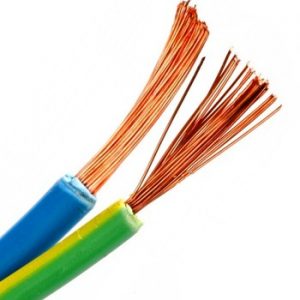
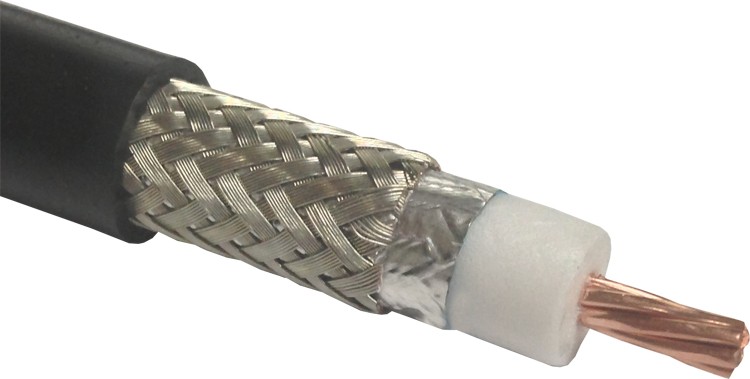
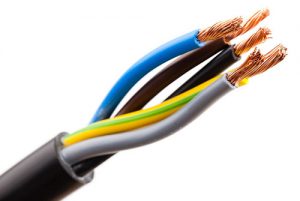
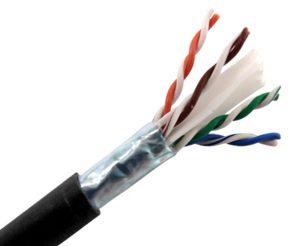

Wire Size
The size of wire is specified by its gauge (American Wire Gauge or AWG) or by its diameter in mm. Resistance of wire is inversely proportional to the cross-sectional area of the wire, so wire with a larger diameter has less resistance per unit distance.
| AWG | Diameter (mm) | Ω/1000 ft. | Ω/km | Max current for chassis wiring (A) | Max current for power transmission (A) | Max freq for 100% skin depth |
| 0 | 8.25246 | 0.0983 | 0.322424 | 245 | 150 | 250 Hz |
| 1 | 7.34822 | 0.1239 | 0.406392 | 211 | 119 | 325 Hz |
| 2 | 6.54304 | 0.1563 | 0.512664 | 181 | 94 | 410 Hz |
| 3 | 5.82676 | 0.197 | 0.64616 | 158 | 75 | 500 Hz |
| 4 | 5.18922 | 0.2485 | 0.81508 | 135 | 60 | 650 Hz |
| 5 | 4.62026 | 0.3133 | 1.027624 | 118 | 47 | 810 Hz |
| 6 | 4.1148 | 0.3951 | 1.295928 | 101 | 37 | 1100 Hz |
| 7 | 3.66522 | 0.4982 | 1.634096 | 89 | 30 | 1300 Hz |
| 8 | 3.2639 | 0.6282 | 2.060496 | 73 | 24 | 1650 Hz |
| 9 | 2.90576 | 0.7921 | 2.598088 | 64 | 19 | 2050 Hz |
| 10 | 2.58826 | 0.9989 | 3.276392 | 55 | 15 | 2600 Hz |
| 11 | 2.30378 | 1.26 | 4.1328 | 47 | 12 | 3200 Hz |
| 12 | 2.05232 | 1.588 | 5.20864 | 41 | 9.3 | 4150 Hz |
| 13 | 1.8288 | 2.003 | 6.56984 | 35 | 7.4 | 5300 Hz |
| 14 | 1.62814 | 2.525 | 8.282 | 32 | 5.9 | 6700 Hz |
| 15 | 1.45034 | 3.184 | 10.44352 | 28 | 4.7 | 8250 Hz |
| 16 | 1.29032 | 4.016 | 13.17248 | 22 | 3.7 | 11 k Hz |
| 17 | 1.15062 | 5.064 | 16.60992 | 19 | 2.9 | 13 k Hz |
| 18 | 1.02362 | 6.385 | 20.9428 | 16 | 2.3 | 17 kHz |
| 19 | 0.91186 | 8.051 | 26.40728 | 14 | 1.8 | 21 kHz |
| 20 | 0.8128 | 10.15 | 33.292 | 11 | 1.5 | 27 kHz |
| 21 | 0.7239 | 12.8 | 41.984 | 9 | 1.2 | 33 kHz |
| 22 | 0.64516 | 16.14 | 52.9392 | 7 | 0.92 | 42 kHz |
| 23 | 0.57404 | 20.36 | 66.7808 | 4.7 | 0.729 | 53 kHz |
| 24 | 0.51054 | 25.67 | 84.1976 | 3.5 | 0.577 | 68 kHz |
| 25 | 0.45466 | 32.37 | 106.1736 | 2.7 | 0.457 | 85 kHz |
| 26 | 0.40386 | 40.81 | 133.8568 | 2.2 | 0.361 | 107 kHz |
| 27 | 0.36068 | 51.47 | 168.8216 | 1.7 | 0.288 | 130 kHz |
| 28 | 0.32004 | 64.9 | 212.872 | 1.4 | 0.226 | 170 kHz |
| 29 | 0.28702 | 81.83 | 268.4024 | 1.2 | 0.182 | 210 kHz |
| 30 | 0.254 | 103.2 | 338.496 | 0.86 | 0.142 | 270 kHz |
Next: Circuits and Analysis
